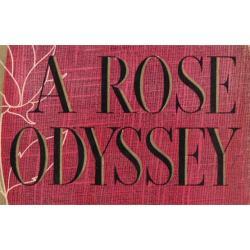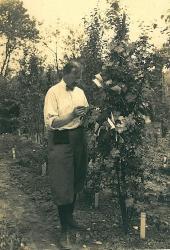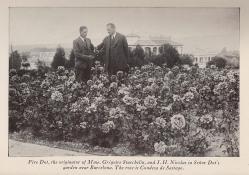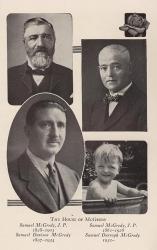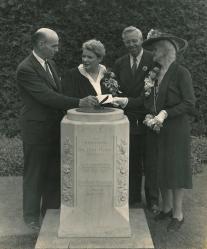PART 2
When I finally made it down to North Carolina in mid July, my mother picked me up at the airport. Instead of driving home we drove to a restaurant where she and my father go every Friday afternoon to have lunch with four other couples who have been friends of our family for the better part of 50 years. My father had already gone over there in his car, so when we arrived I gave him a big hug, along with all their friends seated around their group’s “regular” table. It was nice to see them all again, and little did I know that one of them (a spry ol’ gal by the name of Mrs. West, who was my Sunday school teacher 40 years ago) would play a surprisingly significant role in my “Rose Odyssey” that weekend. But that will have to wait until Part 3 of this story; I don’t want to get ahead of myself. For now, suffice it to say she took a particular interest when our rose project came up in conversation, and told me she had something she’d like to give to me, and would come by the house that weekend to pay a visit.
In the meantime, we all had a nice lunch together, and afterwards my father prepared to drive home in his car, and my mother asked if I wanted to go home, too, or if I would be interested in driving over to Witherspoon Rose Culture in Durham with her in her car. Witherspoon has a magnificent formal rose garden that displays the roses that they sell, and I said I’d love to see it if she didn’t mind making a repeat trip so soon after her initial visit. She was more than willing (another sign she had gotten bitten by the bug), so we hopped on the interstate and arrived less than an hour and a half later.
The day was very hot, hazy and humid, but when we pulled into the parking lot, I looked over at the enormous formal rose garden and knew we would probably spend the rest of the afternoon there. And that’s just what we did. We picked up a map of the garden and slowly wound our way along the symmetrical paths, from one end to the other, stopping along the way to admire each section and grouping of cultivars. I had fun trying to predict the names of different varieties before looking at their “dog tags,” as I like to call their metal identification labels, although there were quite a few varieties that were unfamiliar to me since they aren’t common in my zone back in New York. It was also fun to finally see certain roses that I had often seen in catalogs, but never seen in person – like Vavoom, which really is the color of orange juice!
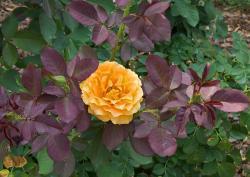
We took many photographs of the garden from different perspectives, including these.
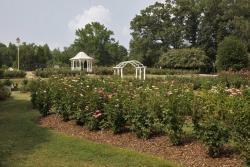

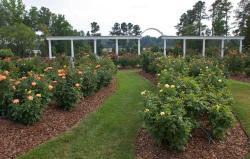
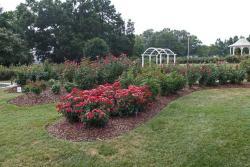
When Witherspoon closed at 5:00 PM, we made the drive back to Winston-Salem and talked about all the roses we had seen, which ones we liked the most, and which ones to add to my mother’s growing wish list. It was a wonderful way to kick off the weekend’s project.
When we pulled into my parents’ driveway an hour and a half later, I saw the 10 enormous holes dug in the new rose bed, and a giant mound of red clay piled high in a corner. The holes were almost perfectly uniform in their dimensions, and my mother told me that she and the landscaper measured each one with a yard stick to ensure it met the minimum dimensions I suggested. What attention to detail – I was seriously impressed! Although I was glad the holes had been dug in advance, I knew I still had a big job ahead of me mixing the loam to fill them back up again.
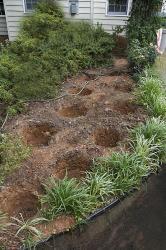
After admiring the preparations that had been made, we walked around the corner to see the roses Mom had purchased and lined up in a row, waiting to be planted. Several were blooming prettily, and though I was tempted to examine each one closely, both my mother and I were a bit tired and thirsty, so instead we went on inside so that each of us could relax with our respective beverages of choice before dinner: Mom made herself a martini, Dad had a Manhattan, and I had a beer. Then we sat down to a delicious dinner of North Carolina style barbecue that Mom prepared for the three of us.
By the time we finished dinner it was growing dark outside, so we decided not to do any work on the rose bed that evening, but agreed to get started bright and early the next day. So the following morning, after breakfast and a second cup of coffee, my mother and I headed outside. She donned her new gauntlet gloves and began moving the roses from the front of the house over to the side bed where they would be planted. Meanwhile I went around back, got the wheel barrow, and loaded it up with the first of many bags of garden soil, compost, and peat moss that would be used that day.
By the time I brought the first load of soil amendments up in the wheelbarrow, Mom had just finished organizing the roses, so I knelt down to get my first good look at them. I started by examining each of the roses she had purchased at Witherspoon a few weeks earlier, and they were just as beautiful and in as good a condition as the ones I had seen there for sale the day before. The staff had done a nice job helping her select good specimens whose leaves and canes were healthy and strong.
Then I turned my attention to the roses that had been purchased at a nearby nursery that while not nationally known like Witherspoon, was still known as a good local sources of roses. Naturally I was eager to inspect the quality of their plants, but was concerned with what I saw: cane borers had visibly burrowed into the piths where many of the canes had been pruned. Some of the canes had begun yellowing beneath the entry hole, where the borers had chewed their way down the pith.
Of course, I had no way of knowing if the roses had been sold to my mother like that several weeks earlier, or if the cane borers had set to work after she purchased them, but in any event they needed some “first aid” before they could be planted. So I began pruning many infested canes, nipping off a half inch at a time until I reached healthy pith, and sealed off the pruning cuts with wood glue. Some of the “shrapnel” that resulted from these gradual cuts were plainly infested with live borers of different kinds, wriggling around inside the tunnels they had burrowed. Although this was frustrating to my mother, it was also a good learning experience in what to look out for, how to seal pruning cuts, and how to deal with infested canes if she should encounter them again.
All but one of the roses looked fine after pruning them, but 'Octoberfest' was reduced to a single viable cane, so we decided we would return it the next day and ask for an exchange. But in the meantime, we had some serious planting to do. So I set to work showing Mom how to mix the loam, and fill each hole about 8 inches from the top. Then we lifted the roses out of their pots, gently loosened the exterior soil of the root ball to help the roots spread out, and placed each rose with the bud union an inch above ground (appropriate for her Southern zone).
We managed to get several roses in the ground before we ran out of soil ingredients, so we took a break, ate some lunch, and drove over to one of the national home improvement centers to get more soil. But I was surprised by what I found there - or rather, couldn’t find there. Rather than the bags of black garden soil or top soil I was accustomed to, their bags of “soil” consisted largely of the type of hard crumbled red clay I was looking to replace. Also, their bags of manure were substantially supplemented with peat moss, which I prefer to add as a separate amendment and still had plenty of back at the house. So we left that store and went to another, where I finally found some bags of good black soil and pure manure, so we loaded up the car and went back home where I continued mixing the loam.
This type of work always takes more time than you think it will, especially when it’s 95 degrees and the sun is bearing down on you, so after getting two-thirds of the roses planted, we decided to wait to plant the remaining roses until the next day. In the meantime, we needed to get cleaned up before relatives arrived to visit. But before we could stop what we were doing, my niece Cate arrived earlier than expected but unnoticed since she parked her car out front on the street instead of the driveway. I’m not sure which one of us was more startled by the other when she came around the side of the house and found me kneeling on my knees inside one of the planting holes, looking like some gleeful gnome rising out of the earth itself.
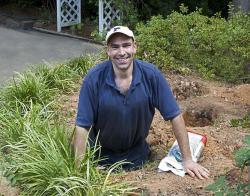
That evening I enjoyed the company of my extended family, all of whom took an interest in the project my mother and I had embarked on. We talked about roses, gardening, and all manner of topics until it came time for each relative to return to their respective homes. Then my parents and I turned in for the night, ready to get up the next day and resume our work.
The next morning my mother and I decided that before resuming our plantings, we would return the rose that had been so decimated by cane borers to the nursery, and ask if they would permit us to exchange it. So we drove over there, and I chatted up some of the very friendly staff while my mother took an interest in some patio furniture on sale before we mentioned the rose we wanted to return. They were more than happy to permit us to exchange it for any other rose in the nursery, earning an A+ for customer service in my book. Moreover, they told us to keep the one we had brought to return, in case we could restore it to good health. So we entered the rose area to peruse the available stock. Not surprisingly, much of it was a little “picked over” given that it was already July, but my mother spotted a 'Dream Come True' that she liked, and I took a close look at it and agreed it was in good shape. Then I looked over and spotted a group of Austin’s ‘Janet’ that were some of the healthiest roses I had seen in a long time, with numerous canes sprouting from the bud unions. I called my mother over and said, “I know these aren’t the right size for the rose we need to replace, but I think these ‘Janets’ are some of best formed rose plants in the nursery. If I were here looking for roses to add to my own garden, I’d take one of these home with me. So keep it in mind for the future, in case you can find the space.”
With that in mind, we returned home with just the 'Dream Come True', along with a patio table and chairs in the back of the car, and resumed our rose planting after lunch. A little while later, the phone rang and my mother went indoors to take the call. When she returned she said that Mrs. West phoned to say she’d like to pay us a visit that evening, but we still had time to finish our work. So we resumed our plantings, and by the end of the afternoon we had gotten all of the roses into the ground, with the exception of the 'Octoberfest' that the local nursery told us to keep. We simply didn’t have the space (or time) to dig a hole for it, so we placed it in a temporary pot, and completed the rose bed by spreading some mulch over it to give it a “finished look,” and to help the soil retain moisture and suppress weeds.
As my mother and I finished up our work, we took a deep breath, smiled, and stood back to admire the fruits of our labor. As the sun began to lower in the sky, the rose bed looked lovely in the waning light, and we knew that all of our planning, timing, and hard work had paid off. We had done it - and best of all it was a collaborative effort. So we took a few photographs to commemorate our accomplishments, and went inside to get cleaned up.

